Copyright © University of Cambridge. All rights reserved.
'Newspapers' printed from https://nrich.maths.org/
Show menu

I don't know whether in your homes, at the weekend, there are lots of newspapers lying about. Maybe you travel by train a lot and when you get into the train there are lots of bits of newspapers on the seats and tables. These things happen because they're not stapled together like magazines usually are [like the ones that tell you what's on the T.V.].
So what we're thinking about is newspaper that has had the pages separated and they're lying about instead of being like they were when they were bought at the shop. We'll think about a very small newspaper in that it only has eight pages. It would be a good idea to have two sheets of paper [the same size] ready now so that we can talk this through more easily. You could use two sheets of paper from a real newspaper [ask the adult who bought the newspaper first!] or just two pieces of A4 folded down the middle. They should look like this:-

Now that you've got these you will need to put one inside the other, fold the two together and then number the pages 1, 2, 3, 4, 5, 6, 7 and 8.
To help you to see my pictures better I've done the numbers in a special way.
When the pages are facing you I put the numbers in a yellow box.
I've pretended that you can see through the thin paper and so you can see the number that's written on the side not facing you. That number I've put into a pink box.
You should write the numbers the correct way round from 1 to 8.
So the middle sheet of the newspaper looks like:-

If I remove that sheet the outside sheet will look like:-

Now you have all that you need so let's have a look at the challenge.
When pages get separated at home we have to try to sort them out and get things in the correct order so that we can follow the stories and pictures.
Let's suppose that in our eight-page newspaper there is just one complete story on each page and so it does not matter what order the pages are in, as long as the writing is not upside down!
How many ways can we arrange the pages [no tearing!] so that the numbering may be different?
Here is a start I've made:
I N N E R - S H E E T - - - - - - - - O U T E R - S H E E T
A)
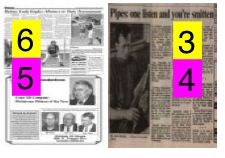
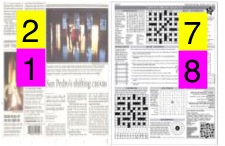
B)
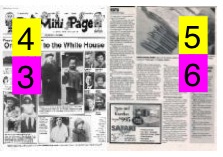
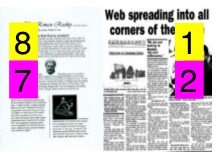
C)
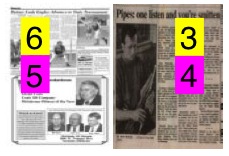
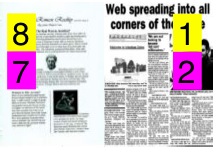
In A) I've turned the inside sheet over so now the pages go 1, 2, 5, 6, 3, 4, 7, 8.
In B) I've got the inside sheet the correct way round but have turned over the first sheet, so now the pages go 7, 8, 3, 4, 5, 6, 1, 2.
In C) I've got both sheets turned over so now the pages go 7, 8, 5, 6, 3, 4, 1, 2.
Now of course there are other things we can do, like we can change the order of the sheets so that one arrangement could be like this.
I N N E R - S H E E T - - - - - - - - - - O U T E R - S H E E T
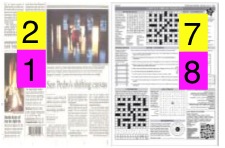
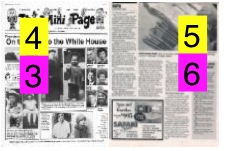
The page numbers now go 3, 4, 1, 2, 7, 8, 5, 6.
Well have a go yourself, be as inventive as you like BUT the writing must be the correct way up.
It would be good to find a way of recording all the page number orders, and look at them all together.
Good luck.
I usually ask you to provide a question like "I wonder what would happen if ...?''. Well I'm going to give you one this time:
What would happen if we had three sheets of paper and so we had twelve pages to number?
If you found a way of doing the first challenge you may be able to use that same system for getting ALL the ways of arranging these three sheet and looking at the numberings that occur. I guess it would be good to then explore these sets of numbers that show the page numberings. [That's a funny word!]